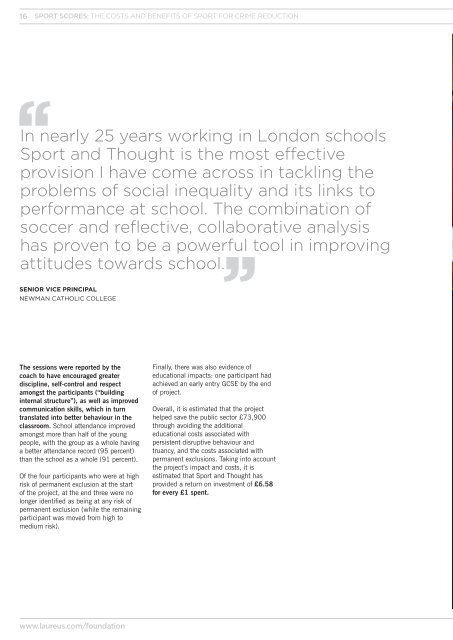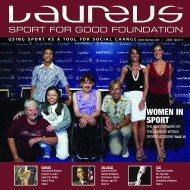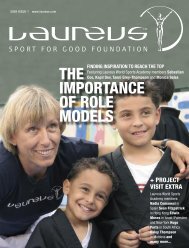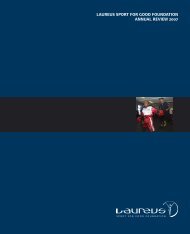Report: Sport Scores - Ecorys UK
Report: Sport Scores - Ecorys UK
Report: Sport Scores - Ecorys UK
Create successful ePaper yourself
Turn your PDF publications into a flip-book with our unique Google optimized e-Paper software.
16<br />
<strong>Sport</strong> ScoreS: the costs and benefits of sport for crime reduction<br />
What We knoW about hoW sport heLps to reduce crime<br />
17<br />
In nearly 25 years working in London schools<br />
<strong>Sport</strong> and Thought is the most effective<br />
provision I have come across in tackling the<br />
problems of social inequality and its links to<br />
performance at school. The combination of<br />
soccer and reflective, collaborative analysis<br />
has proven to be a powerful tool in improving<br />
attitudes towards school.<br />
SENIOR VICE pRINCIpAL<br />
neWman cathoLic coLLeGe<br />
LAuREuS ACADEMy MEMBER MORNÉ Du pLESSIS AND AMBASSADOR MICHAEL VAuGHAN<br />
At tHE LAuREuS-SuppORtED pROJECt uRBAN StARS, uNItED KINGDOM<br />
Not juSt crime reDuctioN<br />
The sessions were reported by the<br />
coach to have encouraged greater<br />
discipline, self-control and respect<br />
amongst the participants (“building<br />
internal structure”), as well as improved<br />
communication skills, which in turn<br />
translated into better behaviour in the<br />
classroom. School attendance improved<br />
amongst more than half of the young<br />
people, with the group as a whole having<br />
a better attendance record (95 percent)<br />
than the school as a whole (91 percent).<br />
Of the four participants who were at high<br />
risk of permanent exclusion at the start<br />
of the project, at the end three were no<br />
longer identified as being at any risk of<br />
permanent exclusion (while the remaining<br />
participant was moved from high to<br />
medium risk).<br />
Finally, there was also evidence of<br />
educational impacts: one participant had<br />
achieved an early entry GCSE by the end<br />
of project.<br />
Overall, it is estimated that the project<br />
helped save the public sector £73,900<br />
through avoiding the additional<br />
educational costs associated with<br />
persistent disruptive behaviour and<br />
truancy, and the costs associated with<br />
permanent exclusions. Taking into account<br />
the project’s impact and costs, it is<br />
estimated that <strong>Sport</strong> and Thought has<br />
provided a return on investment of £6.58<br />
for every £1 spent.<br />
Whilst the focus of this research is on<br />
valuing crime impacts, the example<br />
of <strong>Sport</strong> and Thought highlights the<br />
contribution that the positive behavioural<br />
and attitudinal changes stimulated<br />
by sport can make to broader policy<br />
objectives.<br />
This includes improved attendance<br />
at school and reductions in school<br />
exclusions (with the lifetime cost of a<br />
permanent school exclusion valued at<br />
almost £32,000 per person 6 ). Other<br />
sports projects, involving the 16+ age<br />
group, also aim to help tackle youth<br />
unemployment (with the lifetime cost of<br />
being NEET valued at almost £54,000 per<br />
person 7 ). These outcomes in themselves<br />
can significantly reduce the risk of future<br />
offending, whilst strengthening protective<br />
factors.<br />
The benefits of promoting healthy lifestyles<br />
and encouraging regular exercise through<br />
sport are also well documented, although<br />
rarely valued. For the purposes of carrying<br />
out the Cost Benefit Analysis for this study,<br />
we employ measurements of Quality<br />
Adjusted Life Years, or QALY s (valued at<br />
£20,000 per additional QALY gained 8 ).<br />
We are aware that many sports projects<br />
will have other aims and objectives.<br />
However we consider these to be some of<br />
the most direct and measurable outcomes<br />
from sports projects, which can be valued<br />
with some degree of confidence. Whilst<br />
by no means telling the whole story,<br />
they provide a very useful starting point<br />
for assessing the minimum return on<br />
investment provided by sport for crime<br />
reduction projects, and investigating their<br />
value for money.<br />
6. Financial Cost of Social Exclusion, Follow<br />
up Study of Antisocial Children Into<br />
Adulthood, Scott et al, British Medical<br />
Journal, 2001; Misspent youth, New<br />
philanthropy Capital, 2007<br />
7. Estimating the Cost of Not Being In<br />
Education, Employment or training,<br />
Department for Education and Skills, 2002<br />
8. Weighting and Valuing Quality Adjusted<br />
Life years using Stated preference<br />
Methods: preliminary Results from the<br />
Social Value of a QALy project, Baker et al,<br />
Health technology Assessment, 2010<br />
www.laureus.com/foundation<br />
www.laureus.com/foundation








